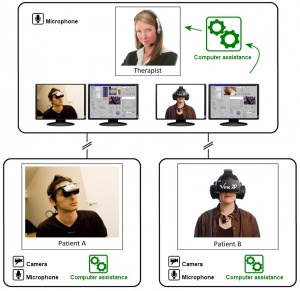Difference between revisions of "User:Cjpaping"
| Line 11: | Line 11: | ||
=== Introduction === | === Introduction === | ||
| − | TU Delft is working on virtual reality exposure therapy (VRET). This is a project using head mounted displays (HMD) to treat patients for various phobias like acrophobia, claustrophobia and agoraphobia | + | TU Delft is working on virtual reality exposure therapy (VRET). This is a project using head mounted displays (HMD) to treat patients for various phobias like acrophobia, claustrophobia and agoraphobia. In its current configuration, it is possible for the therapist to treat one patient at the time. My research explores the possibility of one therapist treating two or more patients simultaneously with the VRET. |
| − | |||
There are numerous reasons why exploring a multiple patient setup could be useful. First of all therapies are expensive and it could be possible that one therapist treating multiple patients in parallel could be a way to reduce the cost of the treatments. It could also be possible that fewer therapists can assist more patients, thus increasing the efficiency and accessibility of the treatments. | There are numerous reasons why exploring a multiple patient setup could be useful. First of all therapies are expensive and it could be possible that one therapist treating multiple patients in parallel could be a way to reduce the cost of the treatments. It could also be possible that fewer therapists can assist more patients, thus increasing the efficiency and accessibility of the treatments. | ||
| Line 33: | Line 32: | ||
'''Poject: Designing a Multiple patient VRET system''' | '''Poject: Designing a Multiple patient VRET system''' | ||
| − | |||
| − | |||
Part 1 | Part 1 | ||
A literature survey | A literature survey | ||
| − | |||
Part 2 | Part 2 | ||
Building senario's | Building senario's | ||
| − | Part | + | Part 3 |
Building A Test system | Building A Test system | ||
| + | Python | ||
| + | Pyglet | ||
Revision as of 15:22, 9 April 2009
Christian Paping
Human-Computer Interaction
E-mail: cjpaping@Hetnet.nl
Project
Project: Designing a Multiple patient VRET system
Introduction
TU Delft is working on virtual reality exposure therapy (VRET). This is a project using head mounted displays (HMD) to treat patients for various phobias like acrophobia, claustrophobia and agoraphobia. In its current configuration, it is possible for the therapist to treat one patient at the time. My research explores the possibility of one therapist treating two or more patients simultaneously with the VRET.
There are numerous reasons why exploring a multiple patient setup could be useful. First of all therapies are expensive and it could be possible that one therapist treating multiple patients in parallel could be a way to reduce the cost of the treatments. It could also be possible that fewer therapists can assist more patients, thus increasing the efficiency and accessibility of the treatments.
There are many different elements that are involved with the design of a multiple patient setup. Questions range from very practical, like where the patients will be located, does the patient need help putting the HMD on, to theoretical and psychological problems. For example, what are good ways for the therapist to cope with multiple patients at the same time and what factors influence the quality of this type of therapy.
Working with multiple patients simultaneously can eventually mean that the therapists might need assistance focusing their attention between patients. This could be done by implementing a computer system, between the patient and therapist, that continuously monitors the patients and warns the therapist if a patient needs attention. There is even the option of extending this system with modules that can take over specific tasks from the therapist if necessary.
Research Goals
The goal of this literary survey is to get a fundamental understanding of the principles involved when creating a multiple patient VRET system. This paper focuses on two facets that are necessary for creating such a system. Firstly the exploration of the excising VRET system and expanding it to a simple multiple patient setup. This also includes looking at the communication between the therapist and patient and understanding how this can change in a multiple patient setup.
Secondly this survey will look at the workload of the therapist and explore how the therapist could cope with two or more patients at the same time. We need to look at their tasks and their user-interface. Assuming the therapist can only assist one patient at the time, there needs to be software that warns the therapist if another patient might need immediate attention.
There could be need for a more complex system; where the computer has the option to take over tasks from the therapist. We need to explore how a computer could take over these tasks and assist the patients autonomously. It could be possible that there is need for additional software which determines when and what task will be taken over from the therapist (Adaptive automation).
The goal of this literary survey is to understand witch elements are necessary for a treating two or more patients with virtual reality. It is key to get a basic understanding how these elements should work and interact with each other.
Poject: Designing a Multiple patient VRET system
Part 1 A literature survey
Part 2 Building senario's
Part 3 Building A Test system Python Pyglet

